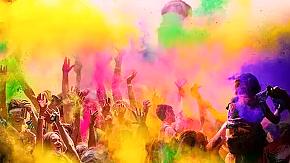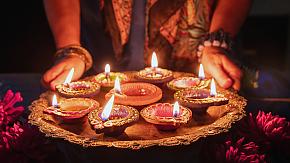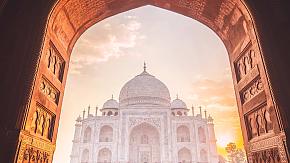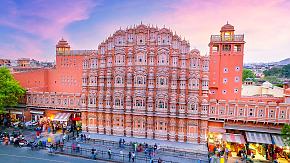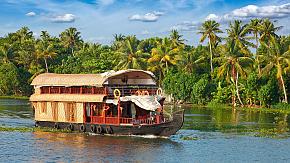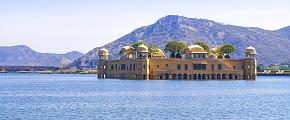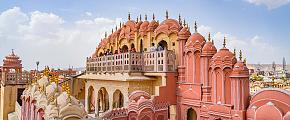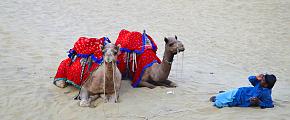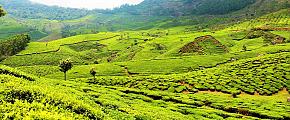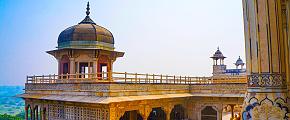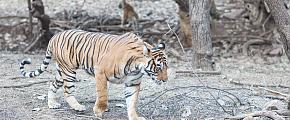Best Time to Visit India: Beaches, Wildlife & Festivals
Knowing the best time to visit India will make your trip enjoyable, with dry, cool weather, and stunning scenery. From October to March, India's festivals like Diwali and Holi immerse you in the festive enthusiasm, and must-see attractions like Goa's beaches await your exploration. If you can't wait to learn about them for your India holiday, read this article for more information and tips.
Weather in India
India is a vast country with a climate that varies according to geographical location. Rainfall in the monsoon season (June to September) is concentrated in the mountainous regions, the plains being relatively dry. The north, like Himachal Pradesh, also Delhi, and Agra, has temperatures over 40°C on the plains in the summer and temperatures dropping to sub-zero in the Himalayas in the winter. Central regions like Rajasthan have a mild climate, with summer temperatures usually ranging from 30°C to 45°C. Besides, with moderate temperatures between 10°C and 25°C, winter is suitable for traveling. The south, such as Kerala and Cochin, has a tropical climate, warm and humid, with temperatures between 15°C and 30°C in winter.
Best Time to Visit India
The best time to visit India is usually during the dry season (October to March), providing good climatic conditions and a wealth of cultural activities. Pleasant weather enhances the beauty of iconic destinations like the Thar Desert and Kerala backwaters, allowing you to appreciate their grandeur under clear skies and surrounded by enchanting scenery. The beaches in the southern region, especially in Goa, are great places to relax or enjoy water sports. Additionally, traditional festivals such as Diwali and Holi give you the opportunity to experience local customs in depth.
Choosing the right time to travel allows you to enjoy a comfortable trip and deeply experience India's stunning landscape. If you're interested in it, it's our pleasure to provide professional advice. Don't hesitate to contact us or write to [email protected]!
Must-Dos During October to March
Enjoy the Festive Atmosphere of Diwali and Holi
These two India's festivals cannot be missed - Diwali and Holi. Diwali is usually held in October or November. At night, every household lights diyas (lamps), as if countless stars. You can stroll through the brightly lit streets and feel the unique tranquility. When fireworks burst into the night sky, excitement hits you. Holi in March is a feast of color and laughter, especially in cities like Delhi and Mathura. You can throw colored powder on others, symbolizing the arrival of spring and the victory of goodness.
Experience Water Sports at Goa's Beaches
Goa's beaches are full of life in winter, with calm sea and shining sun. There are various lively activities, including surfing, windsurfing, banana boat, and other water sports. You can participate in many kinds of activities, feel the sea breeze, and enjoy the cool water at Baga Beach or Palolem Beach. Imagine tasting fresh seafood on the beach, local specialties such as Feni, and watching a beautiful sunset. You'll be amazed that winter in Goa is so leisurely and adventurous.
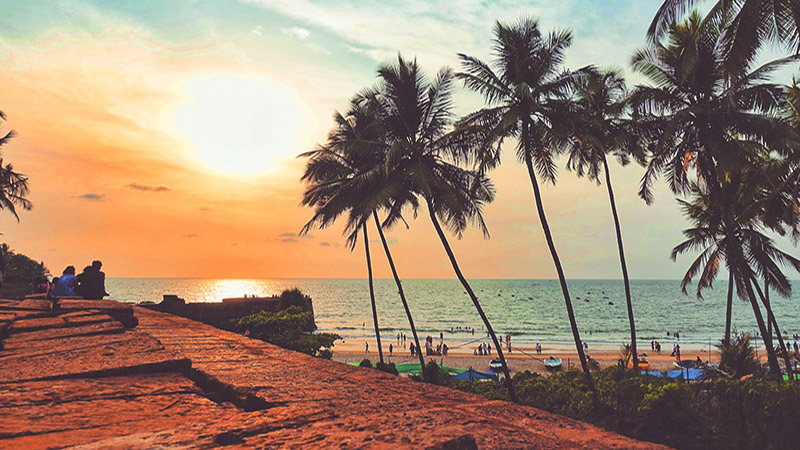 Goa's Beach
Goa's Beach
Embrace Stunning Scenery in Kerala
In winter, the Kerala backwaters are a great place to cruise on a boat or cycle along the banks, through palm trees and rice fields to admire the natural scenery. In the evening, go to Alleppey or Kovalam Beach to watch the magnificent sunset. As the sunset dyes, the sky red and the waves gently hit the beach, you will immerse yourself in the peaceful atmosphere of Kerala.
Relaxing in Rajasthan With Desert Activities
Want to explore the golden dunes and enjoy the vast desert scenery? Start a unique tour - go to the Thar Desert! With sunshine and breeze, desert off-roading, camel riding, sand sliding, and other activities, you'll enjoy the thrill in a vast, quiet atmosphere. At night, you can enjoy a bonfire party, live in the camp, and taste authentic Rajasthani food, accompanied by local music and dance performances, leaving a deep impression of your winter trip.
Spot Wildlife at National Sanctuary
Don't forget to carry a camera to capture wildlife in Ranthambore National Park and make your trip full of surprises. From October to March, the forests come to life with flowers in full bloom, adding brilliant colors around the waters. Wildlife is active, and you can often stumble across them basking in the sun, such as India's Big Five- tigers, elephants, sloth bears, gaur (Indian bison), and leopards. In addition, various birds such as egrets and mandarin ducks roost peacefully in the area, allowing you to listen to the sounds of nature on a peaceful morning.
Things to Do in Off-Season
October to March is considered the best time to visit India. However, if your trip misses this "golden time", don't be discouraged! Every season in India has its unique charm. Let's feel the soul of India in other seasons to embrace change and ensure that your journey is always full of surprises!
Experience the Romance of the Pink Palace in the Rain
In India's monsoon season (June to September), the Hawa Mahal in Jaipur seems to have put on a coat. The drizzle falls gently, covering the palace with a thin layer of mist, and the pink walls glow softly in the moist air, like a painting from a fairy tale. The sky is sometimes gloomy, and sometimes a ray of sunshine is revealed. Imagine walking in the palace garden after the rain, with fresh green grass, washed buildings, and fresh air, and you will feel the calm beauty brought by the rain, away from the hustle and bustle of the city.
 Hawa Mahal
Hawa Mahal
Enjoy the Harvest at National Mango Day
Summer is the harvest season for mangoes, and July 22 is India's National Mango Day. Indian mangoes are known as the "king of fruits", and are highly praised for their sweet taste. During this season, you can buy various varieties of mangoes in the market, and have the opportunity to experience the fun of picking mangoes in some orchards, especially in regions of Maharashtra and Uttar Pradesh. Many cities hold mango festivals to taste various mango desserts, such as mango lassi, mango ice cream, mango chutney, etc. Experiencing the joy of harvesting and feeling Indians' passion for mangoes is a delicious moment that is not to be missed in summer!
Explore the Valley of Flowers
The Valley of Flowers National Park, hidden in the Himalayas, enters its enchanting flowering period in July and August. With the arrival of the monsoon season, thousands of wildflowers bloom, forming a colorful sea, and attracting a large number of tourists to experience the isolated natural wonders. Hiking through this magical sea of flowers, you will see rare plants such as blue poppies, orchids, and primroses, and you may encounter wild animals such as snow leopards and black bears.
A Glimpse of Sacred Ganesh Chaturthi
Ganesh Chaturthi is usually celebrated in September to pray to the elephant god for wisdom, wealth, and good fortune. The procession is one of the highlights, with drums, traditional instruments, and enthusiastic shouts of devotees. You can join the procession and feel the joy and sacred reverence of the locals. The final scene is exciting - the Ganesha statue is slowly sent into the river or sea, symbolizing the return of the deity to nature. When you witness this sacred moment, you will feel inner peace and tranquility.
Tips for Traveling in India
Book in Advance
Planning and booking hotels and transportation in advance can ensure a smooth trip, especially during the festival periods and March to May. Many tourists go to the hill resorts of Himachal Pradesh like Shimla and Darjeeling. Booking in advance allows you to get better rates and choose from a wider variety of accommodation options to enjoy this wonderful vacation.
Pack Warm Clothes
If you plan to go to northern hill stations or desert areas, carry warm clothing, gloves, and scarves to help you beat the cold. While it may be warm during the day, temperatures can drop significantly at night.
Prepare Waterproof Suits
During the monsoon season (June to September), rainfall is relatively frequent. It is advisable to carry a lightweight folding umbrella or a waterproof raincoat, as this will ensure that you remain comfortable. Besides, a waterproof backpack will protect your belongings from getting wet.
Drink Plenty of Water
Walking in a hot summer may quickly make you thirsty and tired, so drinking plenty of water is vital. Odynovo's private transfers will provide refreshing bottled water to ensure you keep hydrated, healthy, and comfortable.
Bring Allergy Medication
During the monsoon season or in humid areas, there may be an increase in mold, pollen, and other allergens in the air. If you have a history of allergies, it is recommended to consult your doctor and carry some anti-allergy medications, which are effective in relieving symptoms such as sneezing, runny nose, and skin irritation.
Prevent Altitude Sickness
If you plan to visit high mountain areas, such as the Himalayas, be aware of the altitude changes. It is better to rest for a few days after your arrival and avoid strenuous exercise.
Related Posts You May Like
What Our Clients Say
Explore the latest verified reviews of Odynovo's travel services on Tripadvisor, Google, Trustpilot, Product Review and more trusted platforms.

